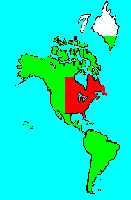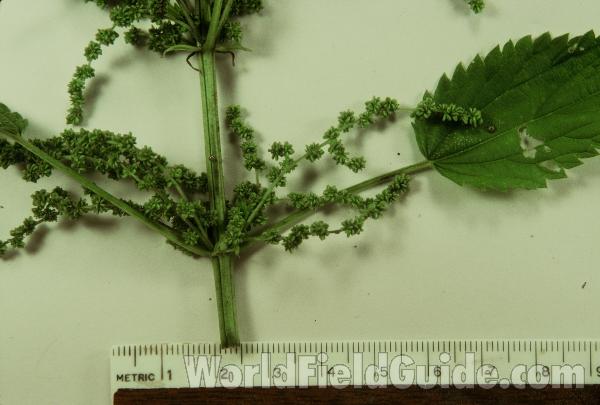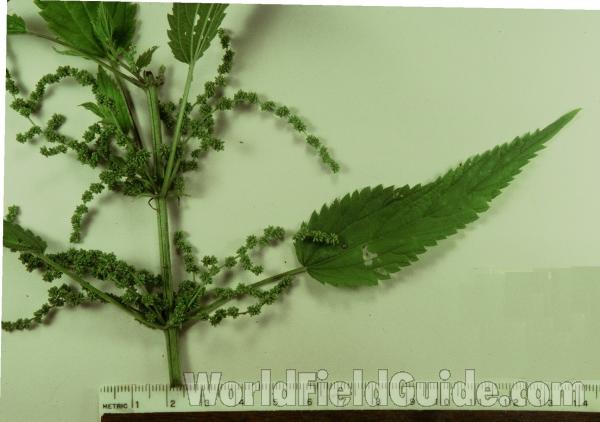SPECIES INFO
Slender nettle (Urtica gracilis = Urtica procerus) is an unpleasant weed that is found in the eastern United States.Stinging nettle genus (Urtica) is found widely in the Northern Hemisphere. There are perhaps 100 different species. This is a group of plants that have stinging hairs. (One should be careful not to touch these plants.) These are either annual or perennial herbs with toothed leaves. The flowers are in panicles, cymes, or racemes that grow from the leaf axils.
The taxonomy of this group is complicated, and the taxonomy is certainly not settled. In Europe and the Northern Hemisphere one finds Urtica dioica and Urtica urens. In southern Europe one finds Urtica pilulifera.
In the 1913 Britton and Brown Flora of Eastern North America, the following species were listed: Urtica dioica is naturalized from Europe. Urtica gracilis is found from Newfoundland to British Columbia and south to Louisiana and Colorado. Urtica urens is naturalized from Europe. Urtica chamaedryoides is found from Kentucky to Arkansas and south to Georgia and Texas.
In a Flora of the Pacific Northwest, Hitchcock and Cronquist) as published in 1973, and published with corrections in 1976 we find Urtica urens and Urtica dioica. However, Urtica dioica has two subspecies: ssp dioica and ssp gracilis. They show gracilis varieties: holosericea, procera, angustifolia, californica, lyallii and gracillis.
In Kartesz, we find the following species: ballotifolia, chaemaedryoides, dioica, gracilenta, and urens. (Kartesz makes gracilis a subspecies of dioica, and adds another subspecies, holosericea, also to dioica. Urtica gracilenta appears in an Arizona Flora. Kartesz moves procera and lyalii into subspecies of Urtica dioica ssp gracilis.)
In Turner and Gustafson, Wildflowers of the Pacific Northwest, as published in 2006, they mention ssp gracilis and ssp holosericea under Urtica dioica.
Nettle Family (Urticaceae) is found almost worldwide except for the extreme colder areas. This family contains just over 1,000 species spread among about 52 genera. There are 14 genera with about 60 species growing in greater North America.
The members of the nettle family can be herbs, shrubs, or trees. Some species have obnoxious stinging hairs. The leaves can be alternate or opposite. The simple leaves are sometimes asymmetrical. The margins can be entire or toothed. The flowers are small and green.
Elm and Mulberry Order (Urticales) is usually broken down into four different families. Although the Nettle family contains some herbs, most members of this order are trees and shrubs.
Dicots (Dicotyledoneae Class) are the predominant group of vascular plants on earth. With the exception of the grasses (Monocots) and the Conifers (Gymnosperms), most of the larger plants that one encounters are Dicots. Dicots are characterized by having a seed with two outer shell coverings.
Some of the more primitive Dicots are the typical hardwood trees (oaks, birches, hickories, etc). The more advanced Dicots include many of the Composite (Aster) Family flowers like the Dandelion, Aster, Thistles, and Sunflowers. Although many Monocots reach a very high degree of specialization, most botanists feel that the Dicots represent the most advanced group of plants.
Seed plants (Phylum Embryophyta) are generally grouped into one large phylum containing three major classes: the Gymnosperms, the Monocots, and the Dicots. (Some scientists separate the Gymnosperms into a separate phylum and refer to the remaining plants as flowering plants or Angiospermae.)
For North American counts of the number of species in each genus and family, the primary reference has been John T. Kartesz, author of A Synonymized Checklist of the Vascular Flora of the United States, Canada, and Greenland (1994). The geographical scope of his lists include, as part of greater North America, Hawaii, Alaska, Greenland, Puerto Rico, and the Virgin Islands.
Kartesz lists 21,757 species of vascular plants comprising the ferns, gymnosperms and flowering plants as being found in greater North America (including Alaska, Hawaii, Greenland, Puerto Rico and the Virgin Islands.
There are estimates within the scientific world that about half of the listed North American seed plants were originally native with the balance being comprised of Eurasian and tropical plants that have become established.
Plant kingdom contains a large variety of different organisms including mosses, ferns, and seed plants. Most plants manufacture their energy from sunlight and water. Identification of many species is difficult in that most individual plants have characteristics that have variables based on soil moisture, soil chemistry, and sunlight.
Because of the difficulty in learning and identifying different plant groups, specialists have emerged that study only a limited group of plants. These specialists revise the taxonomy and give us detailed descriptions and ranges of the various species. Their results are published in technical journals and written with highly specialized words that apply to a specific group.
On the other hand, there are the nature publishers. These people and companies undertake the challenging task of trying to provide easy to use pictures and descriptions to identify those species.



